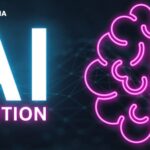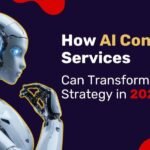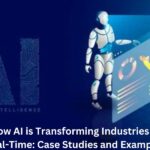The construction industry is one of the world’s oldest, but it’s finally getting a huge technological upgrade. The most valuable asset on any project today isn’t the crane or the bulldozer; it is the AI in construction that drives better planning, smarter building, and safer jobsites. Experts now figure that using AI in construction industry workflows can cut project costs by as much as 20% and shorten timelines by 15%. This is a huge deal for an industry famous for delays.
This is why construction AI is now so important. This guide, written by someone who has watched the industry change, explains the practical uses of AI. It shows exactly how artificial intelligence in construction is being used today in planning, civil engineering, and right there on the jobsite.
Understanding How AI Is Transforming the Construction Industry
Resource: ConstructIQ
When we talk about artificial intelligence in construction, we mean using smart software like Machine Learning (ML) and Computer Vision to handle big problems. These tools automate routine tasks, analyze huge amounts of data, and make smarter, predictive decisions. Unlike simple software, the AI learns from every project’s data, making it better and more accurate over time.
Construction has traditionally been slow to change. This industry struggles with cost blowouts, long delays, and complicated risks. AI and construction solutions directly attack these problems. They use data to give managers foresight, helping them move from fixing problems after they happen to preventing them entirely.
AI in Planning and Design: From BIM to Automated Modeling
The time spent before construction even starts is where AI makes big savings. Smart planning means you avoid expensive mistakes later.
Automated Design and BIM Integration
AI in planning and design works closely with Building Information Modeling (BIM) data. Tools like Autodesk AI and Forma use generative design. They can instantly create thousands of layout options. The AI checks each design against real rules like sun exposure, zoning laws, and local traffic patterns. This massively speeds up the crucial design stages.
Civil engineers and architects save days of work. Instead of manually modeling every scenario, the AI quickly finds the best design.
Fast and Accurate Quantity Takeoffs
Figuring out costs is slow work, and humans often make mistakes. Construction AI tools use deep learning to read complicated 2D plans in seconds. They generate accurate quantity takeoffs, figuring out how much material you need. This frees up estimators to focus on evaluating bids and risks, instead of manually measuring walls and windows. Better accuracy means contractors submit more competitive and reliable bids.
AI in Construction Management and Project Coordination
AI in construction management helps project leaders get total control over complex schedules, materials, and money.
Predictive Scheduling
Construction schedules are always at risk from bad weather, late materials, or workers being unavailable. AI-powered platforms look at historical performance, how long it takes to get materials, and even weather forecasts. They then constantly update the schedule, predicting potential delays weeks ahead of time. The system suggests millions of sequencing options to find the fastest and cheapest way to finish.
Smarter Risk Identification
Project risk involves more than just the schedule. AI looks at contract documents, site photos, and team emails. It flags financial or legal risks before they become huge problems. For example, if a company hired for a job keeps turning in incomplete safety reports, the AI can warn the manager about a possible compliance problem early on.
Civil Engineering Applications: Smarter Analysis and Infrastructure Decisions
AI in civil engineering gives engineers powerful ways to analyze complex ground conditions and check the health of bridges and roads.
Site Analysis and Optimization
Before any construction starts, AI can process vast amounts of geographical information. It analyzes things like soil stability, flood risks, and environmental conditions at the site. This helps civil engineering software choose the best place for big projects like new bridges or tunnels. Choosing the right spot early means the structure will be safer and more stable for years.
Structural Health Monitoring (SHM)
For maintaining old public works—like bridges, dams, or large buildings—AI is a game-changer. AI-based SHM systems use sensors placed inside the structure. They constantly track things like vibration, stress, and temperature. The AI learns the structure’s normal pattern. When it sees something strange, it predicts when a part might fail or when major repairs are needed. This helps owners avoid catastrophic failures and costly emergency repairs.
AI on the Jobsite: Safety, Quality, and Real-Time Monitoring
The construction site is where construction AI changes dangerous, unpredictable work into safer, more controlled processes.
Real-Time Safety Monitoring
Construction is sadly one of the most dangerous jobs. AI-powered computer vision uses cameras already set up on site to watch what is happening instantly. It detects unsafe actions right away.
The AI can see if a worker is missing a hard hat, if someone walks too close to a moving crane, or if a safety railing is broken. This is huge: the system alerts the site supervisor immediately. They can fix the problem before an accident happens. This proactive approach prevents accidents far better than waiting for a scheduled safety check.
Progress Tracking and Quality Control
Checking construction progress by hand is slow and often wrong. Systems use AI and 360° cameras to scan the entire jobsite every day. The AI then compares what’s built against the original BIM model. It instantly spots mistakes, missed work, or quality problems, which minimizes expensive rework later in the project.
Essential Construction AI Tools and Cloud Platforms
The power of construction AI tools comes from the way they connect all the project data in one place. Most solutions run on cloud based construction software.
| Tool Category | What the Tool Does | Why the AI is Important |
| Design & BIM | Helps architects and engineers create building designs. | Handles automated drafting and instantly checks for design conflicts. |
| Project Management | Keeps track of budgets, teams, and timelines. | Predicts risks and recommends the best way to use resources. |
| Site Monitoring | Watch the jobsite using cameras and sensors. | Detects safety problems and tracks how much work is done each day. |
| Scheduling | Creates and updates the master project timeline. | Uses millions of scenarios to find the fastest way to build. |
These platforms connect design, schedule, budget, and site data. This makes sure every person on the team is working from the same true information.
Practical Use Cases: Real Examples from Projects and Firms
It is important to see the technology in use. Companies are using AI in construction today to save a lot of money and time.
Contractors now embed sensors in their large machinery. The AI analyzes things like engine vibration and temperature. It predicts when a component will fail. This lets the team schedule maintenance during planned breaks, avoiding sudden, costly breakdowns.
Major firms have used generative design to optimize the structure of bridges. The AI created many different structural models. It found the design that used the least amount of material while still meeting all safety rules. This results in smarter, more environmentally friendly engineering.
Surveying teams are much faster now. They use AI algorithms to process photos taken by drones and laser scans. This gives them highly accurate topographic surveys and measurements of earth moved much faster than older, manual methods.
Benefits of Applying AI Across Construction Workflows
Using AI in construction industry solutions gives projects five main advantages that directly improve the company’s financial results:
- You build faster: Automating things like material lists and checking documents lets skilled workers focus on complex, high-value tasks.
- You control costs: AI improves estimates and material planning. This directly reduces waste, overspending, and unexpected equipment failure costs.
- Jobsites are safer: Real-time hazard detection protects workers and cuts down on expensive legal and financial costs from accidents.
- Quality improves: AI-driven quality checks minimize the need for expensive rework later in the project schedule.
- Managers make better decisions: Project leaders use verified, up-to-the-minute data instead of guessing or waiting for old reports.
Challenges and Barriers to AI Adoption in Construction
Even with the huge benefits, AI in construction struggles with several serious barriers.
The biggest issue is big data quality. Construction data is often messy and stuck in different systems that do not talk to each other. Over half of industry experts say that bad data is the number one challenge for AI success. AI models cannot learn effectively from inconsistent data.
The high initial cost of specialized tools is another problem. Smaller contractors often cannot afford the upfront investment. There is also a severe shortage of internal technical expertise. Many companies lack the staff needed to manage these advanced systems. Plus, there is often cultural resistance. Workers and managers sometimes worry about the technology or fear being constantly watched.
How to Start: Practical Steps for Pilots and Scaling AI Solutions
You do not need to replace all your technology to use AI in construction management. You must start small, prove that the technology works, and build a strong data foundation.
- Solve a Single Problem: Choose one small, easy-to-measure task, like automatically generating material lists or using your existing site cameras for simple safety checks.
- Focus on Your Data: Before buying expensive software, clean up your data processes. Make clear rules for how data is collected, shared, and stored across all projects.
- Run a Pilot: Do a small trial project. Measure the return on investment (ROI) clearly. Did it save money, cut waste, or stop an accident? Use that success to get funding for the next phase.
- Train Your Team: Managers need training. They must understand how to read AI insights and control the new tools. Workers need to know that the AI is there to help them, not to replace them.
The Future: Trends Shaping AI in Construction and Civil Engineering
The future of construction is heading toward autonomous sites. We are moving toward AI and construction solutions that do more than just monitor; they execute tasks automatically.
A huge trend is Generative AI for design. Soon, civil engineers will use simple spoken prompts to have the AI instantly design the best road layouts, drainage systems, or bridge components. This will make complex civil engineering software much easier to use.
Robotics and smart equipment are another growing trend. AI-guided robots are already automating repetitive layout tasks on jobsites. This will expand to include welding, concrete pouring, and digging, greatly improving productivity and helping with the growing worker shortage. The combination of smart design tools like Autodesk AI and autonomous robots will fundamentally change how infrastructure is built.
Frequently Asked Questions (FAQs)
What is the main use of AI in pre-construction?
The main use is in planning and estimation. AI instantly analyzes design data to create faster, more accurate quantity takeoffs. It also optimizes the project schedule by looking at millions of possible building sequences.
How does AI improve safety on a construction site?
AI uses computer vision to analyze live video from site cameras. It instantly detects unsafe situations, such as workers without hard hats or people moving too close to heavy equipment. The system then sends real-time alerts to managers.
What is the biggest barrier to adopting AI in the construction industry?
The biggest barrier is poor data quality and fragmentation. AI systems need large amounts of clean, consistent data to learn, but construction data is often messy and stuck in many different, incompatible systems.
Does AI replace BIM software like AutoCAD?
No. AI enhances BIM tools like Autocad AI features in Autodesk products. AI works with BIM models by analyzing the data they contain. This gives managers better insights and automates design changes, making the overall design process faster.
What is Structural Health Monitoring?
Structural Health Monitoring (SHM) uses AI to analyze data from sensors embedded in existing structures like bridges. The AI looks for patterns that mean a structure is stressed or weak, allowing owners to schedule needed repairs before a major failure happens.
Sources & References
- https://www.gov.uk/government/news/ai-growth-zones-to-create-thousands-of-jobs-and-unlock-up-to-100-billion-in-investment-as-new-site-confirmed-for-north-wales (GOV.UK, AI Growth Zones to create thousands of jobs and unlock up to £100 billion in investment, 2025)
- https://smartdev.com/ai-use-cases-in-construction/ (SmartDev, Unlock AI Use Cases in Construction: The Ultimate Guide, 2025)
- https://www.stackct.com/blog/real-life-examples-of-artificial-intelligence-in-construction/ (STACK, Real-Life Examples of Artificial Intelligence in Construction, 2025)
- https://www.gihub.org/infrastructure-technology-use-cases/case-studies/ai-and-sensors-for-safe-construction/ (Global Infrastructure Hub, AI and Sensors for Safe Construction, 2020)
- https://www.mckinsey.com/capabilities/tech-and-ai/our-insights/superagency-in-the-workplace-empowering-people-to-unlock-ais-full-potential-at-work (McKinsey, AI in the workplace: A report for 2025, 2025)
- https://www.aidataanalytics.network/data-science-ai/news-trends/data-quality-availability-top-list-of-ai-adoption-barriers (AI, Data & Analytics Network, Data quality & availability AI adoption barriers, 2025)
- https://www.truelook.com/blog/5-real-world-use-cases-for-ai-in-the-construction-industry/ (TrueLook, 5 Real-World Use Cases for AI in the Construction Industry, 2024)
















